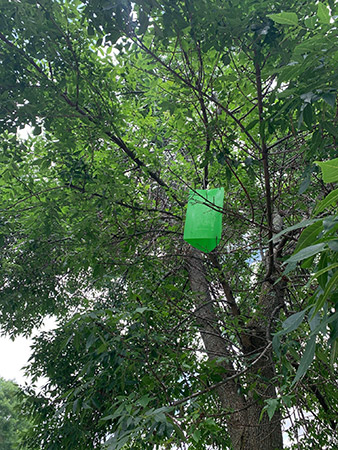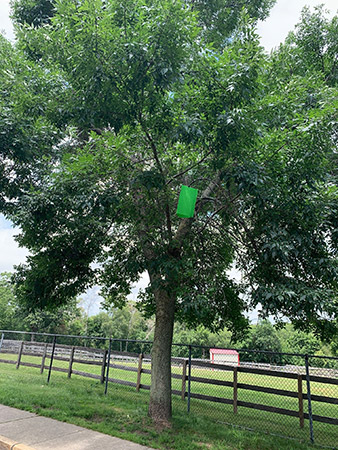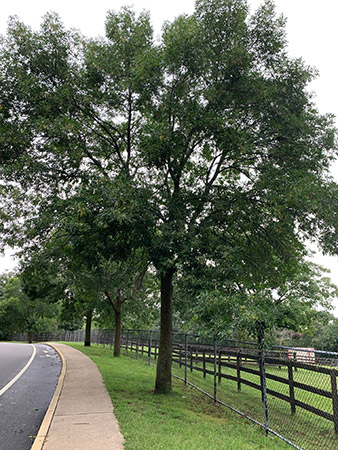Emerald Ash Borer (EAB) is an invasive species that attacks and kills ash trees. The City of Providence has implemented preventative measures to treat selected ash trees to minimize infestations and preserve City-owned ash trees. To learn more about EAB, how to identify an ash tree, and the treatment methods being used, use the dropdown below.
What is an Emerald Ash Borer (EAB)?
EAB were first found in Rhode Island in July 2018. EAB were originally discovered in Detroit in 2002 and have since spread to 35 states. EAB attack ash trees of all species, and ultimately kill any infested ash tree (Source: Rhode Island Department of Environmental Management – RIDEM). Learn more about EAB from RIDEM here.
EAB were first found in Rhode Island in July 2018. EAB were originally discovered in Detroit in 2002 and have since spread to 35 states. EAB attack ash trees of all species, and ultimately kill any infested ash tree (Source: Rhode Island Department of Environmental Management – RIDEM). Learn more about EAB from RIDEM here.
How did the City of Providence find EAB in Providence?
EAB were first found in Providence in July 2018 through a trapping and monitoring program implemented by the City Forester and performed by Forestry crews. Twenty traps were hung in green ash trees throughout the City. Around the same time, EAB were discovered in southern Rhode Island by the RI Division of Environmental Management. Providence Forestry crews set out monitoring traps again in 2019 and 2021. The counts each year have increased dramatically, demonstrating a rapidly expanding population.

EAB were first found in Providence in July 2018 through a trapping and monitoring program implemented by the City Forester and performed by Forestry crews. Twenty traps were hung in green ash trees throughout the City. Around the same time, EAB were discovered in southern Rhode Island by the RI Division of Environmental Management. Providence Forestry crews set out monitoring traps again in 2019 and 2021. The counts each year have increased dramatically, demonstrating a rapidly expanding population.


Why are these insects a danger to our tree population?
EAB have killed tens of millions of trees across the eastern United States and Canada. The insects cannot be eradicated. The pest deposits its eggs beneath the bark of ash trees, and the larvae feed on the xylem layer of the tree. Ash trees begin to die within 5 years of an infestation.
EAB have killed tens of millions of trees across the eastern United States and Canada. The insects cannot be eradicated. The pest deposits its eggs beneath the bark of ash trees, and the larvae feed on the xylem layer of the tree. Ash trees begin to die within 5 years of an infestation.
How do I identify an ash tree?
An ash tree is a large shade tree with opposite, compound leaves. Its bark has crisscrossing furrows. Seeds are winged, and hang in clusters when present.
An ash tree is a large shade tree with opposite, compound leaves. Its bark has crisscrossing furrows. Seeds are winged, and hang in clusters when present.


What is the City of Providence doing to address EAB?
The City Forestry Division is taking a preservation approach as funding allows. This means that selected trees are being treated to prevent infestation, rather than the City removing trees entirely before infestation occurs. Street trees are chosen for preventative treatment based on a ranking system that includes factors such as size, condition, damage to surrounding infrastructure, potential growing space, growing in parks, and tree equity criteria (if the tree is growing in a low canopy/low income/racially diverse neighborhood).To maintain the preventative approach, current research suggests that trees must be treated every two years in perpetuity.
The City Forestry Division is taking a preservation approach as funding allows. This means that selected trees are being treated to prevent infestation, rather than the City removing trees entirely before infestation occurs. Street trees are chosen for preventative treatment based on a ranking system that includes factors such as size, condition, damage to surrounding infrastructure, potential growing space, growing in parks, and tree equity criteria (if the tree is growing in a low canopy/low income/racially diverse neighborhood).To maintain the preventative approach, current research suggests that trees must be treated every two years in perpetuity.
What treatment is being used on the ash trees? Why did the City select this treatment?
City-owned ash trees in Providence are being treated with Azadrachtin, a systemic, bio-insecticide. It is injected into the trunk of the tree. Azadrachtin is the most environmentally-safe option to treat these trees.
City-owned ash trees in Providence are being treated with Azadrachtin, a systemic, bio-insecticide. It is injected into the trunk of the tree. Azadrachtin is the most environmentally-safe option to treat these trees.
How many trees are being treated in 2021 and where are they located?
The City currently has trees on a 2-year rotation. There are 339 trees being treated city-wide along streets and in parks.
The City currently has trees on a 2-year rotation. There are 339 trees being treated city-wide along streets and in parks.
Will the City treat my ash tree?
Only trees that have received the highest priority rankings will be treated by the City. Contact the Forestry Division to find out if the street tree in front of your home is an ash tree, and if it is being treated. If you are interested in pursuing treatment for a privately-owned ash tree in your backyard, click here to learn about treatment options before hiring a contractor.
Only trees that have received the highest priority rankings will be treated by the City. Contact the Forestry Division to find out if the street tree in front of your home is an ash tree, and if it is being treated. If you are interested in pursuing treatment for a privately-owned ash tree in your backyard, click here to learn about treatment options before hiring a contractor.

